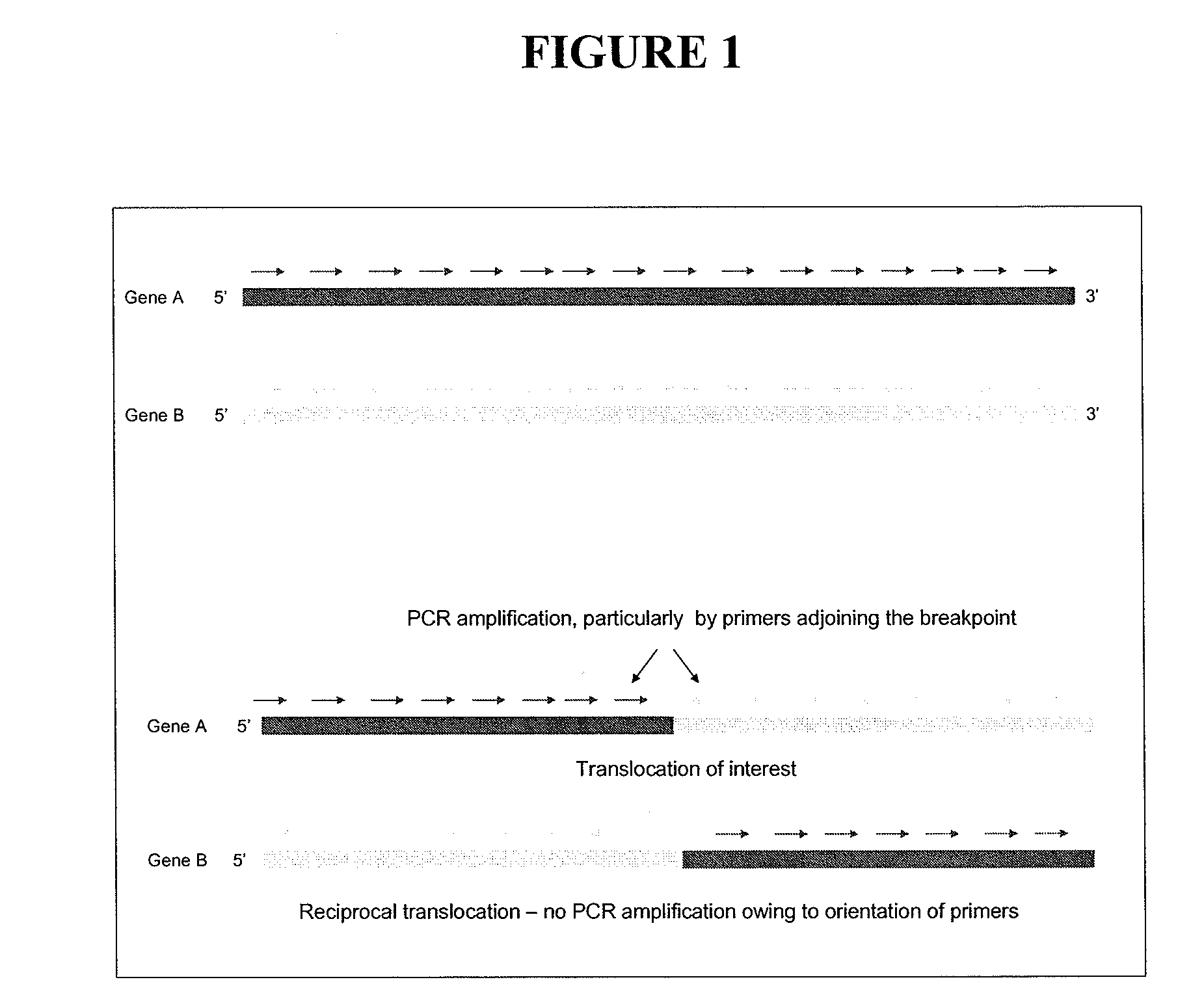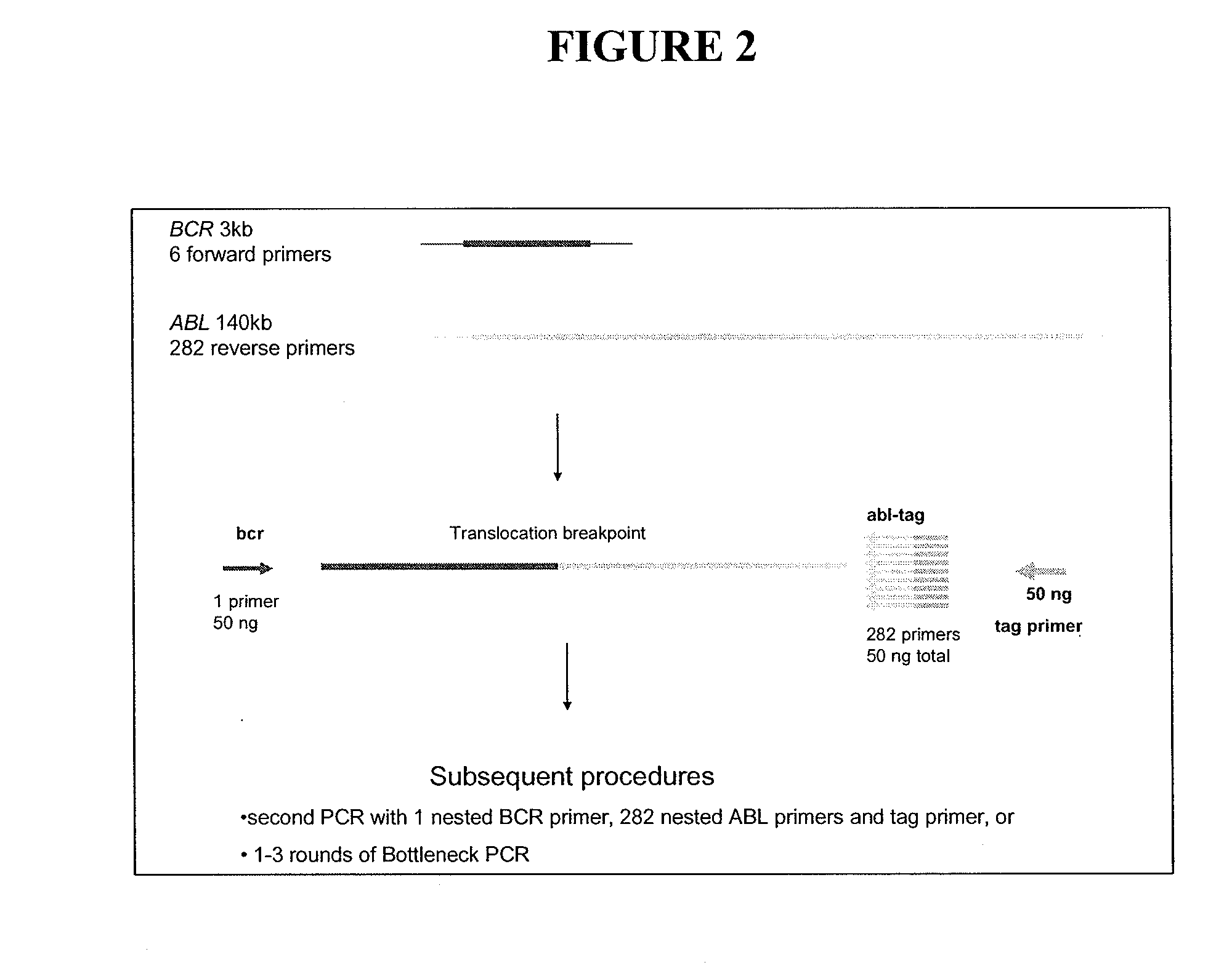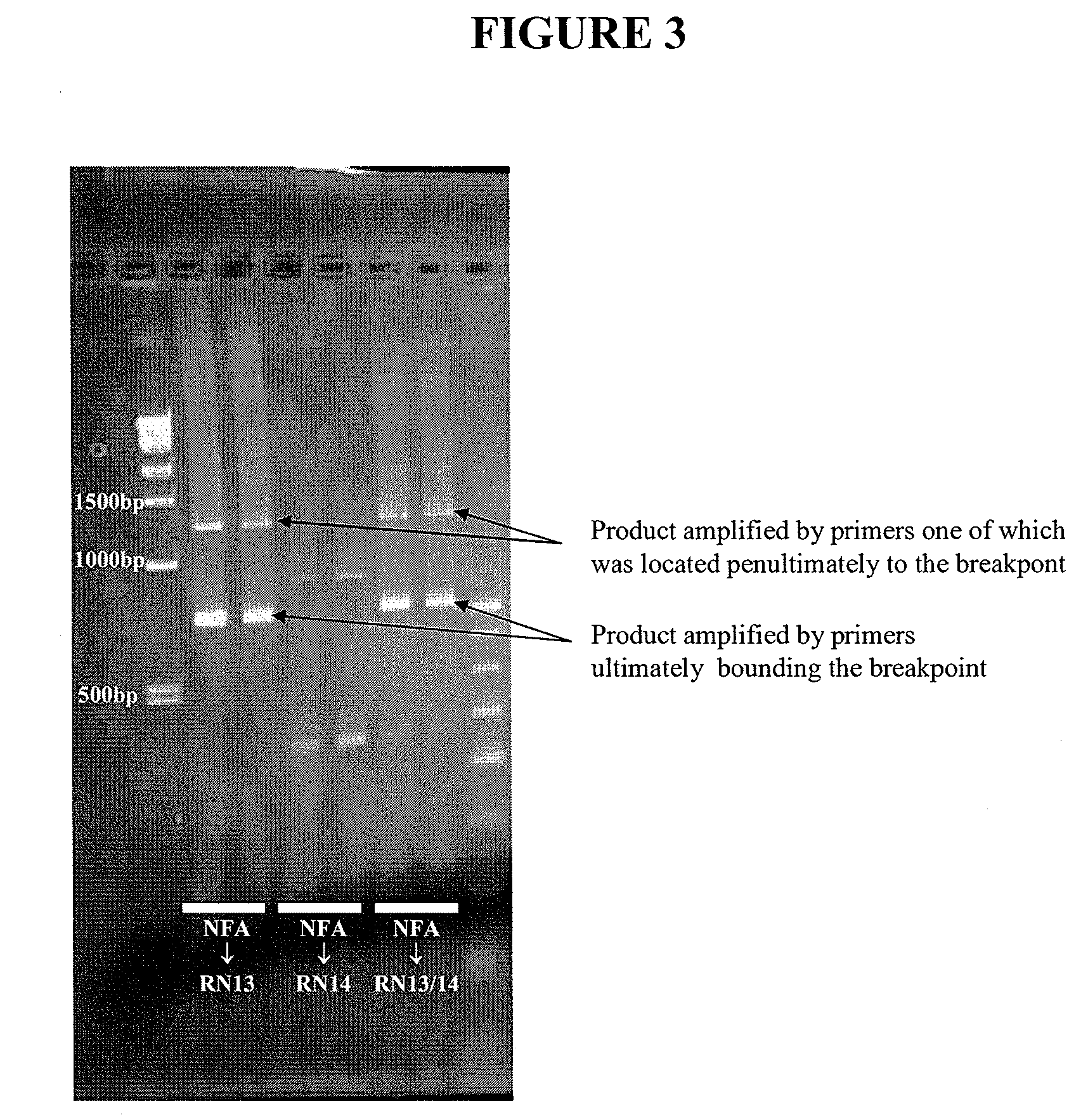Method for DNA breakpoint analysis
a breakpoint and analysis method technology, applied in the field of identifying a breakpoint and agents, can solve the problems of abnormal offspring, abnormal miscarriages or children, abnormal offspring,
- Summary
- Abstract
- Description
- Claims
- Application Information
AI Technical Summary
Problems solved by technology
Method used
Image
Examples
example 1
Isolation of BCR / ABL Breakpoint Product from gDNA of Patient 1
[0236]Genomic DNA extracted by Qiagen Flexigene kit[0237]1st Round PCR (50 ng genomic DNA)—all reactions performed in duplicate
[0238]Forward primer pool—FA (Contains 7 forward BCR primers BCRF1-BCRF7 each with same 5′ tag sequence (A), Total 50 ng (7.14 ng each)
[0239]Reverse primer pool—R3 / 4 (Pool of 24 oligonucleotide reverse ABL primers, each with same 5′ tag sequence (C), Total 50 ng (2.08 ng each)
[0240]Forward and reverse tag sequence primers (A,C)—25 ng of each
PCR Conditions
[0241]1×PCR buffer, 5 mM MgCl2, 0.75 ul dUTP (300 uM each), 0.4 ul Platinum Taq (2 U)
Cycling Conditions
[0242]95 / 4 min
[0243](97° C. / 1 min, 65° C. / 20 min, 72° C. / 1 min)×5
[0244](96° C. / 30 sec, 65° C. / 20 min, 72° C. / 1 min)×5
[0245](92° C. / 30 sec, 65° C. / 20 min, 72° C. / 1 min)×10[0246]2nd Round PCR (1st round reaction diluted 1 / 200 in sterile water)
[0247]Forward primer pool—NFA (Contains 7 forward internal BCR primers BFN1-BFN7 each with same 5′ tag sequ...
example 2
Primers Used for Isolation of BCR-ABL Translocation Breakpoint in Chronic Myeloid Leukemia
BCR Primers
[0283]
1st RdBCRF1-FT0cttctccctgacatccgtggBCRF2-FT0 (-5)acacagcatacgctatgcacatgtgBCRF3-FT0gaggttgttcagatgaccacggBCRF4-FT1 (-10)cagctactggagctgtcagaacagBCRF5-FT0tgggcctccctgcatccBCRF6-FT0tccccctgcaccccacg2nd RdBCRF1-FT1tgacatccgtggagctgcagatgcBCRF2-FT1acatgtgtccacacacaccccaccBCRF3-FT1accacgggacacctttgaccctggBCRF4-FT1 (-4)ctggagctgtcagaacagtgaaggBCRF5-FT1tccctgcatccctgcatctcctccBCRF6-FT1cccacgacttctccagcactgagc
[0284]The second round primers were internal to the first round primers and were used either for a second round together with internal ABL primers or for performing Bottleneck PCR in order to eliminate non-specific amplified material and facilitate isolation of the translocation breakpoint.
[0285]Various combinations of the forward and reverse primers can be used. In one embodiment, the protocol that was used was to set up 6 PCRs, each containing a different BCR primer and all 282 ...
example 3
Identification of the PML-RARalpha Breakpoint
[0286]Amplified patient DNA was electrophoresed on a 2% agarose gel. P is patient DNA, N is the normal DNA and W is the water control. The patient DNA was amplified using multiple RARα primers and a single PML primer[0287]a) Amplified patient DNA electrophoresed on a 2% agarose gel, P is patient DNA, N is the normal DNA and W is the water control. The patient DNA was amplified for one round using an RARα primer and a PML primer designed using the breakpoint sequence.[0288]b) The sequence chromatogram obtained from the patient DNA. The breakpoint between PML and RARα is shown.
Isolation of the PML-RARalpha Breakpoint in Acute Promyelocytic Leukemia
[0289]Two patients have been studied and the breakpoint has been isolated and sequenced in both. The primers used are shown in Example 4.
PUM
| Property | Measurement | Unit |
|---|---|---|
| TM | aaaaa | aaaaa |
| TM | aaaaa | aaaaa |
| size | aaaaa | aaaaa |
Abstract
Description
Claims
Application Information
 Login to View More
Login to View More - R&D
- Intellectual Property
- Life Sciences
- Materials
- Tech Scout
- Unparalleled Data Quality
- Higher Quality Content
- 60% Fewer Hallucinations
Browse by: Latest US Patents, China's latest patents, Technical Efficacy Thesaurus, Application Domain, Technology Topic, Popular Technical Reports.
© 2025 PatSnap. All rights reserved.Legal|Privacy policy|Modern Slavery Act Transparency Statement|Sitemap|About US| Contact US: help@patsnap.com



